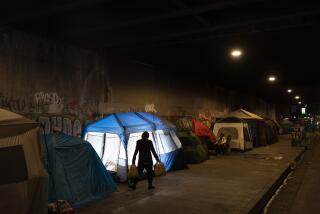KING CASE AFTERMATH: A CITY IN CRISIS : Numbers Show Most Blacks Remain Mired in Poverty : Statistics: Cut off from the mainstream economy, many inner-city blacks lag behind even the newest immigrants.
- Share via
WASHINGTON — One of every three black residents of America’s cities is officially poor, compared with just one in seven urban whites.
An inner-city household headed by a single woman, a category that includes more than half of all urban blacks with children, stands a three-in-five chance of being trapped in poverty.
There is not much hope to be found in statistics such as these, but they help explain the rage that is boiling over in Los Angeles and other urban areas across the nation.
The verdicts in the beating trial of black motorist Rodney G. King clearly were the trigger for this week’s riots. “But the background is a long background of neglect. It is very much a product of the neglect of the inner cities for the last 25 years,” said Margaret Weir, a Harvard University social sciences professor.
Black Americans are better off today than they were during the bloody Watts riots of 1965, U.S. Census statistics show. Median incomes have risen after accounting for inflation, while the poverty rate has fallen.
But most of those gains occurred in the early years of the Great Society programs enacted during the Lyndon Johnson Administration. Since 1969, the overall black poverty rate has shown little improvement and has worsened dramatically among residents of the nation’s cities.
Cut off from the mainstream economy, inner-city blacks, who once fared better than those in rural areas, are falling farther behind the rest of the black population. The poverty rate among urban blacks had risen to 33.8% in 1990 from 21.2% in 1969, according to census figures. The poverty rate for white central-city residents was 14.3% in 1990.
Even more distressing, 34% of all black children born in inner cities will remain officially poor throughout the first decade of their lives, census figures show. The comparable rate for white children is 3%, indicating that whites manage to escape the bonds of poverty more readily than blacks.
By the government’s measure, a family of four is considered poor if its income in 1990 was less than $13,359.
The increasing prevalence of poverty in America’s cities reflects profound demographic changes over the past quarter-century. Urban problems have driven many middle-class residents to the suburbs, leaving the central cities largely to the poor.
And in urban areas, overall poverty rates have roughly doubled since 1969. With that increase has come spiraling crime, unemployment and despair.
For generations, California blacks enjoyed a comparatively higher standard of living than blacks in other parts of the country. Since 1980, they have lost most of that advantage, according to the California Department of Finance.
The national poverty rate among blacks declined slightly over the past decade, falling to 31.9% in 1990 from 32.2% in 1980. However, it soared in California, rising to 24.7% in 1990 from 17.5% a decade earlier, the state figures show.
A similar trend is evident among Latinos. A decade ago, Latinos in California were slightly more prosperous than those in other parts of the nation. By 1990, the state’s Latino poverty rate was rapidly approaching the national level of 28.1%.
By contrast, California’s Asian population enjoyed a dramatic improvement in living standards, with their poverty rate falling to 13.4% from 17.6% over the 10 years.
Often, Asian immigrant success stories in Los Angeles are attributable to family-owned small businesses opened in poor neighborhoods where blacks believe they have been shut out of economic opportunity. Even before the King verdict, this economic contrast had fostered resentment and even violence between blacks and newly prosperous immigrant groups.
Last year, blacks in South-Central Los Angeles staged a summer-long boycott of a liquor store where a black man had been shot by the Korean owner, and tensions flared again when a Korean-born grocer was sentenced to probation for the fatal shooting of a 15-year-old black girl.
Friction between ethnic groups has grown worse as inner-city neighborhoods that were once predominantly black have been flooded with new Latino and Asian residents, many of them recent immigrants. The past decade brought a reversal of the long decline in inner-city population in the Los Angeles basin, with some older communities experiencing growth rates of 30% or more.
Now, blacks often find themselves minorities even within traditionally black neighborhoods, where housing and jobs are increasingly in short supply.
Blacks now account for just 7% of the state’s population, down from 8% a decade ago. They are outnumbered by Asians, who have surged from 5% of the population in 1980 to 9% today, according to the Governor’s Office of Planning and Research.
“A new wave of immigrants has led to unexpected population increases in the state’s inner cities,” according to a 1991 study of the state’s population boom by the governor’s office. “Whites and blacks have moved out of the state’s older communities and have been replaced by new immigrants with larger families.”
And the poor blacks left behind in those inner-city neighborhoods find themselves increasingly isolated from both the white community and the increasingly affluent black middle class, which has largely moved to the suburbs. Now, 49% of black income is earned by the richest 20%, an even greater disparity than exists among whites.
More to Read
Sign up for Essential California
The most important California stories and recommendations in your inbox every morning.
You may occasionally receive promotional content from the Los Angeles Times.













